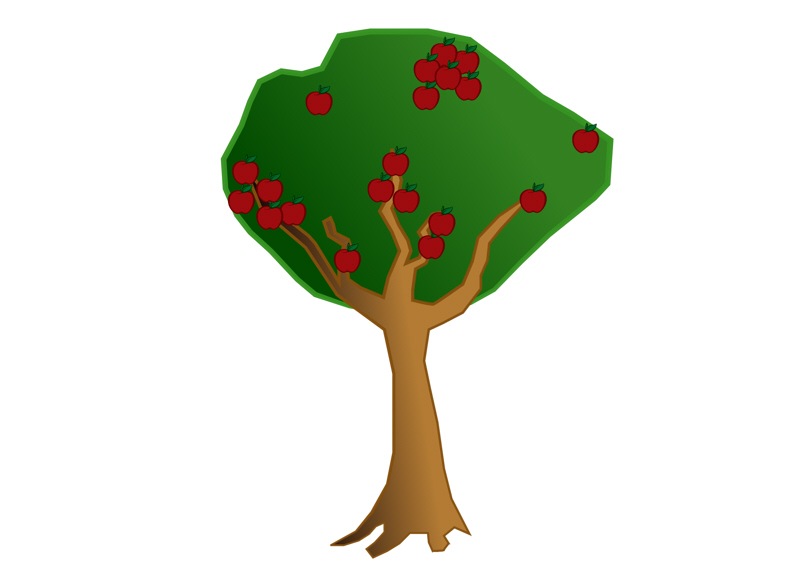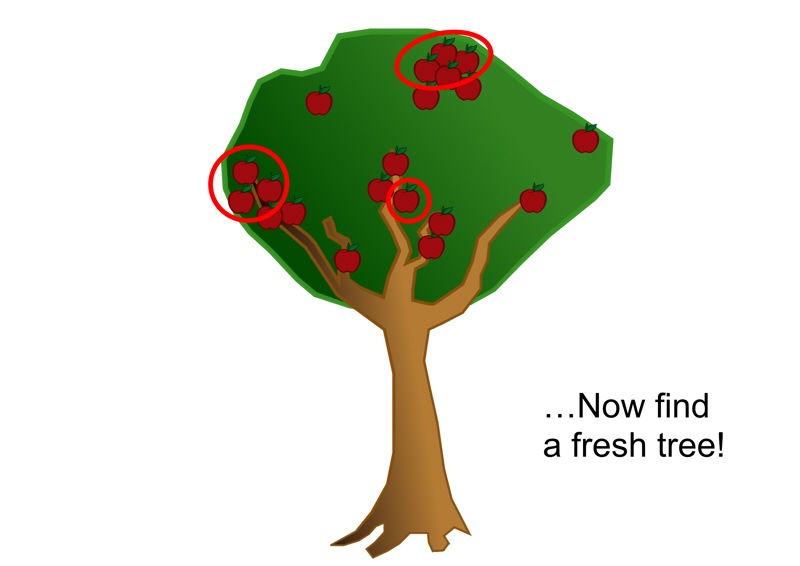Have you ever been fruit-picking?
If so, you will have encountered one of behavioural ecology’s most classic challenges…When do you give up on one patch and start picking in another??
If you leave a good patch too early, you are missing out on the high returns for little effort…BUT if you pick every last berry from one patch, you take longer and longer to find each new ripe (worthwhile) berry to pick. At some point, you would be better to leave the depleted patch and look for another “super-abundant” patch and take advantage of the rapid, easy-pickings there instead of grinding away with less and less return on your effort.

When you think about it, this is basically the same problem facing professional anglers (like the “Shokuryoshi” or professional mountain-men subsistence fly fishers of Japan) who needed to be as efficient as possible in using an artificial fly and casting line for catching fish to sell or eat for survival. It can also be extremely valid for many formats of river fly-fishing competition (where anglers are highly mobile and may have long expanses of river to choose from).
Would you like to know what the biological solution to those same challenges is?
It lies in what I think was a wonderfully classical and elegant (though not now so fashionable) approach to understanding the nature of behaviour. It is a field of study known as “optimal foraging theory” and probably the most useful and fascinating thing I can share with you is the central idea behind the whole thing…
And that is simply:
“You should forage in a spot with abundant berries/fish/whatever you are collecting(!) right up until you have depleted those resources down to the average abundance of the whole area…and then you should leave and find another abundant patch”.
Simple, and absolutely brilliant!!
OK, I admit that it isn’t immediately easy to picture what those words mean though. Here’s an example to show you exactly how this works…
Let’s say you have a whole apple tree with 10 branches and a total of 20 apples (like the picture below). That is an average of 2 apples per branch…only those apples (just like fish in a river!) are not spread perfectly evenly in space. Instead some branches might have zero apples, and others might have 4 or 6…

Optimal foraging tells you that, in order to be most efficient (and in ecology terms as well as subsistence fly fishing terms, this means in order to do what you need to survive instead of dying!), you need to collect from the branches with lots of apples – right up until you have two apples left on that branch. THEN it is better to go and find another branch with many more than two apples…

Of course animals, fruit-pickers and anglers (even those funny beasts called competition anglers) don’t go around with a phone-app or pencil and paper calculating what the average abundance for entire areas of habitat are…It is largely a matter of instinct. But now that you know what the scientifically-optimum approach is – I just bet you can find tons of situations that you can apply this idea to.
Go Ishii is fond of saying that “you fish tenkara with your feet” (meaning that you are always ready to be mobile in search of the most viable fish). Once you have a feel for the average rate that a river is yielding fish that you can catch, Optimal Foraging theory tells you exactly when to sit tight and when to move on…
That latter idea of “moving on” seems to come EXTREMELY reluctantly to very many river anglers “Just one more cast” in that spot seems to be just so tempting…
Often it is less taxing and frustrating to take a short walk, maybe sit back and really observe the river before choosing a new spot to fish. Once in that spot, you can try it out quickly (and quite lightly) before moving on again. In fact, for the Catch & Release hobby angler, it is far, far better to leave a spot well before the point at which it is only giving up its fish at the average rate for the whole expanse of water…It keeps things fresh and varied – while letting other anglers also enjoy the river too.
I hope you enjoy these blog lessons where I mix classical biology with fly fishing and tenkara (Let me have a Thumbs Up OR a Thumbs Down by email on paulgaskellflyfishing@gmail.com by twitter @PaulNGaskell, by registering and commenting on this post below or in Tenkara in Focus Facebook group (https://www.facebook.com/groups/TenkaraInFocus)
Paul

very interesting! I remember alsa thai in Italy we have some statisical study available on line about the density of fishes in various points of rivers: “carta ittica” (ictic cards) are caled and are documents mades from administrations for the rivrs managment……..may be a suggestion for this sytrategy…. 🙂 … thanks! 🙂
Super interesting Paolo, many thanks for sharing. 🙂
Great theory Paul, well explained. I reckon that is my problem, I am trying to catch fish in spring when there aren't any apples on the trees. Maybe I will catch more in autumn at harvest time!
Best wishes and dreaming of tight lines, Vince
ps You'll be pleased to know I was outbid on the WTT auction for a day with you, as per your previous lessons I seem to be able to repeatably find proven techniques that do not catch fish, in time when I have proven all the techniques that fail I will find those that succeed.
Ha ha ha – love it Vince; keep at it… On a lot of rivers in our neck of the woods it seems like a fair proportion of trout are willing to snack on streamers just now – with fish also rising to brief hatches when they occur.